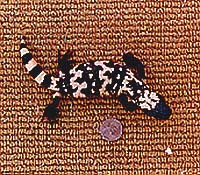Gila monster
| Gila monster Heloderma suspectum Rattlesnakes are particularly dangerous snakes found in the New World. |
The Gila Monster Heloderma suspectum (pronounced Hee'-la) is one of only two species of venomous lizards, its cousin the Mexican Beaded Lizard being the other. With its generally sluggish behavior and benign disposition, it nonetheless must be treated with caution. It can bite quickly and hold on tenaciously. The bite of Heloderma suspectum, while not considered lethal, is very painful and should be considered a medical emergency.Rather than injecting venom through hollow fangs like venomous snakes, Gilas have enlarged, grooved teeth in their lower jaw. When they bite, their powerful jaws chew the venom in through capillary action along the grooves in these teeth. Gila monster venom is about as toxic as that of a western diamondback rattlesnake. However, a relatively small amount of venom in introduced in a Gila bite.
Two subspecies
are recognized: the southern subspecies, the Reticulated Gila Monster (Heloderma
suspectum suspectum) and the northern subspecies, the Banded Gila Monster
(Heloderma suspectum cinctum). |
|
On an interesting note, a component of Gila monster venom called Exendin-4 is currently being investigated as a promising new drug to treat type 2 diabetes. This peptide stimulates the secretion of insulin in the presence of elevated blood glucose levels. It also has the effect of slowing gastric emptying. Phase I clinical studies have recently begun with this exciting investigational drug.Range
The Gila Monster Heloderma suspectum occurs from extreme southwest Utah to southern Sonora and northern Sinaloa; extreme southwest New Mexico to southern Nevada and just into California.The northern subspecies is the Banded Gila Monster H. s. cinctum and the southern subspecies is the Reticulated Gila Monster H. s. suspectum. Heloderma suspectum occurs up to an elevation of 1500 meters. It has been observed to be more common in the wetter, rockier paloverde-sequaro desert scrub association than the drier, sandier creosote bush-bersage association. Heloderma suspectum also seem to prefer rocky foothills and avoid open flats and agricultural areas.
Behavior
Gila monsters spend most of their lives hidden below the ground. This is responsible for the limited information we have about them. There are three things that make them particularly well suited for the harsh environment in which they live.First, they are large lizards (the largest in the U.S.) measuring to about 22 inches in total length and are able to store more energy than smaller lizards. They store fat in their tail and in their bodies. Second, they are capable of eating relatively large meals. They have been observed in the wild eating meals up to one third of their body weight. Third, Gilas have low resting metabolic rates.
Their low metabolic rates, and the ability to eat large meals, combined with their large capacity to store fat, make frequent searching for food unnecessary. Therefore, they are rarely seen above ground. It has been suggested that Gilas can consume their entire yearly energy budget in three or four large meals.
Most of their above ground activity occurs in 3 months in the spring. Not only is this when mating occurs, but it is when their main source of food (vertebrate nests) is most abundant. They are mainly diurnal (active during the day) with activity occurring mainly in the morning.
Gila monsters have a home range of about one square mile. They are usually solitary animals, but do gather in communal areas in the spring for mating.

